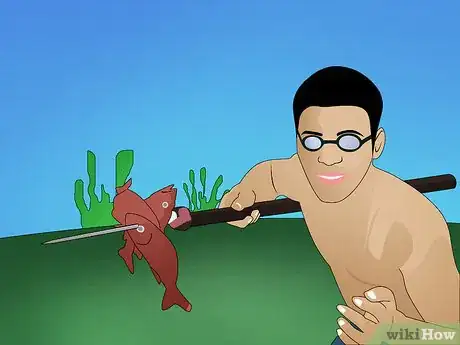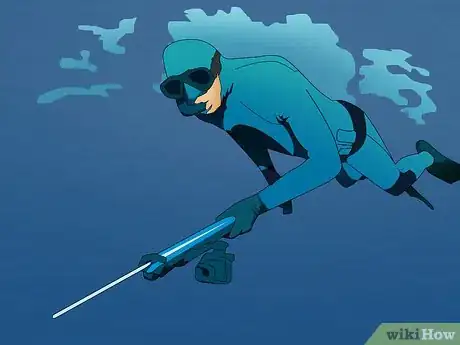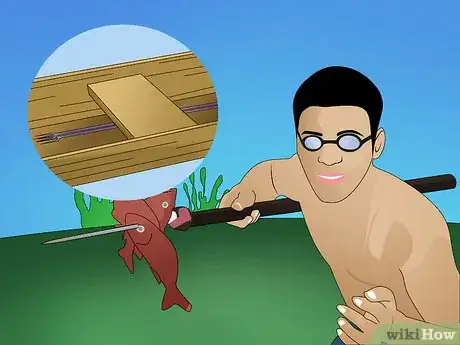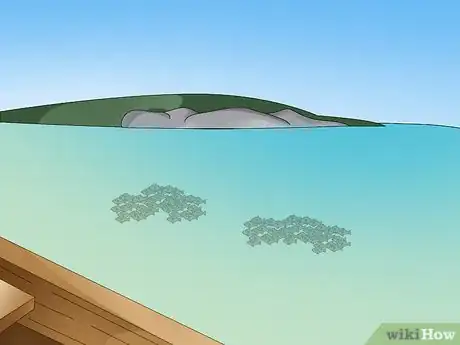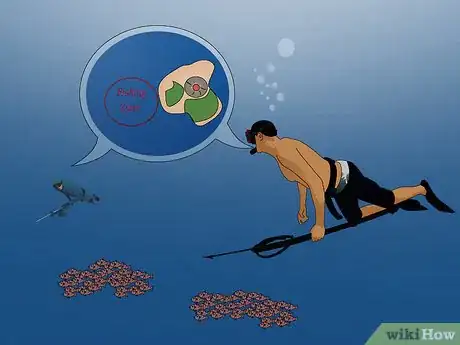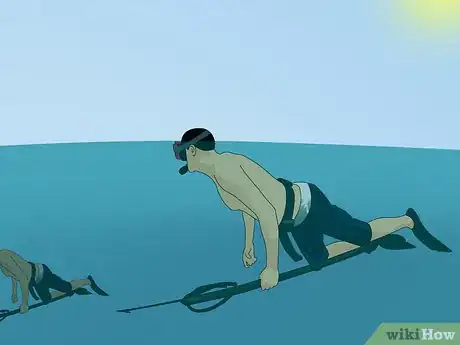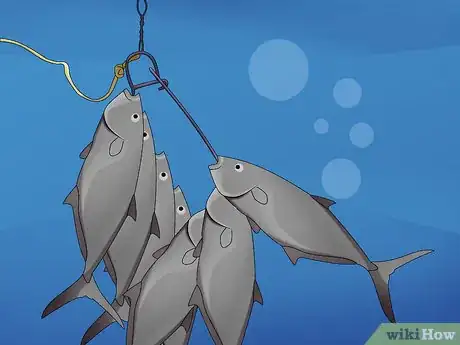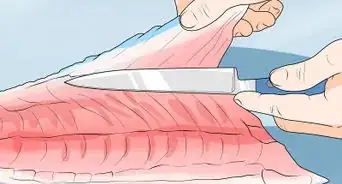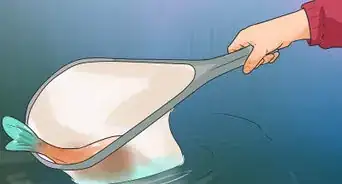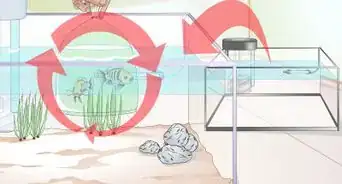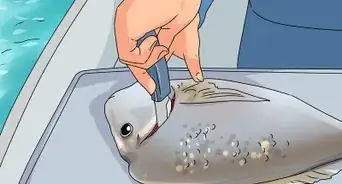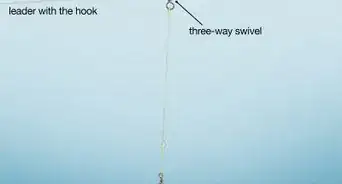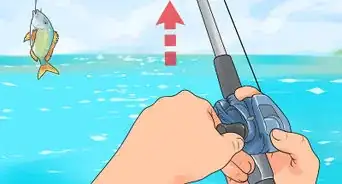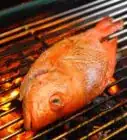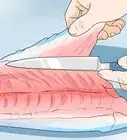This article was co-authored by wikiHow Staff. Our trained team of editors and researchers validate articles for accuracy and comprehensiveness. wikiHow's Content Management Team carefully monitors the work from our editorial staff to ensure that each article is backed by trusted research and meets our high quality standards.
This article has been viewed 168,210 times.
Learn more...
Spearfishing requires concentration, good technique, patience, and the right equipment in order to effectively hunt and spear fish underwater. Whether deep in the ocean or in shallow water near the shore, spearing a fish is an exciting, although sometimes dangerous sport that can provide a sense of accomplishment once you have obtained your prey.
Steps
Selecting a Spear
-
1Choose a pole spear. Often, those that are new to spearfishing start with pole spears because they are lightweight, cost effective, and easy to use. It is believed that longer pole spears are more effective. Pole spears made of aluminum work well on larger fish.[1]
-
2Choose a speargun. Spearguns are generally used by more advanced fishers and which speargun you decide to use depends on the type of fish that you want to hunt. Each type of speargun, regardless of the manufacturer, feels different in different environments, so it can be very difficult to choose.
- While you can decide between pneumatic guns, wood guns, and euro guns, you may not know which type of of gun is best until you have had practice with various types of guns. Beginners should start with a small speargun. It is best to start with the less expensive model.
- Most spearguns are measured in cm, ranging from 60 up to 140+.
- 60-80cm is reserved for close distances (<6 ft range) and is best suited for dense kelp forests or "hole hunting", where the fish are normally stationary.
- 90 - 110cm is suitable for larger/faster fish in the 6–12 feet (1.8–3.7 m) shooting distance, and is good for hunting fish in reefs and in bottoms depths from 10 - 60 ft.
- Choose a gun longer than 110 centimeter (43.3 in) if you are hunting larger fish in clear, open water. Look into buying a floatline and float, so you don't lose your gun (or the fish).
Advertisement -
3Bring an extra spear. Consider placing an extra pole spear or speargun in your kayak or boat so that you do not get all of the way to your destination and have to turn around because of a problem with the equipment.
Identifying a Location
-
1Choose clean and clear water locations. Look for clear water where there are plenty of meandering fish. Poor water quality can result in illness. Popular spearfishing destinations are Wisconsin, Panama, Puerto Rico, and Nicaragua.[2]
- Get an understanding of the type of fish that you want to find so that you know what you are looking for.
-
2Spearfish in remote locations. You can locate a remote beach and rent a kayak to find healthy, great tasting fish.[3]
- If you are deep dive spearfishing, try to find a location where there are no other people spearfishing to reduce the risk of your dive.
-
3Set diving boundaries. Prior to your dive, establish with your dive partner the radius for the dive and the overall timeframe so that you are aware of each other’s location at all times. This will also serve as a precaution should one of you get lost or experience problems, particularly during a deep dive.
Using Proper Spearfishing Technique
-
1Start with shallow water spearfishing. To get comfortable with spearfishing, start out in shallow water and fish above the water line. This does not require total body submersion.
- There are different ways to perform shallow water spearfishing. It can be as easy as standing onshore and spearing fish with a sharpened stick. You can also stand in the water, stand on rocks, or use a kayak as a spearfishing platform.
- In shallow water you can use a technique known as "stalking" where you hunt fish that are just below the surface, on the surface, or near rocks and ridges. Different types of fish have different behaviors that you will learn to recognize over time.
- While in shallow water, you can spearfish just below the surface using a snorkel to enter the water for a short period of time.
- Above the water line spearfishing may be the safest method because it avoids the dangers of underwater diving.
-
2Go free dive spearfishing. Free dive spearfishing is an underwater method of spearfishing that requires a breathing apparatus. To achieve great diving technique, breathe deeply, arch your back as you would diving into a swimming pool, and enter the water head first with your fins in the air allowing your weight to push you towards the bottom. Quietly glide through the water to observe the ocean life and locate your desired fish.
- Use a dive mask for longer dives and a snorkel for shorter dives.
- If you are wearing a wetsuit, you will need a weight belt.
- Be sure not to kick your legs for momentum until you are completely submerged into the water, and then only make slight movements so that you do not frighten your prey.
- Once you reach your desired location in the water, creep slowly towards the fish using your free hand to navigate yourself. Gently kick your legs and hide or camouflage yourself from your prey wherever possible.
-
3Follow safety guidelines. Spearfishing presents more challenges than the standard rod and line fishing because you are in the water as a predator hunting prey. Some of the dangers include sharks, anglers (individuals fishing with a rod and line), and those spearfishing who may mistake you for prey or accidentally hit you with a spear.
- Always have a partner when spearfishing so that you can look out for each other, especially if you are deep dive spearfishing.
-
4Target your prey. When using a pole spear, extend your arm halfway out so that there is room to lengthen your reach at the final moment of attack. Once you've established that the fish is within range of the fully released spear, extend your arm and release the spear in one smooth movement, aiming for the head of the fish.
- If using a speargun while shallow water or deep dive spearfishing, you do not have to extend your arm to release a spear, simply release the safety and point the speargun at your target.
-
5Spear your prey. Aim for the base of the skull where the spine connects because it immediately kills the fish and prevents suffering. After hitting your target, grab either the fish or the protruding point of the spear to control the flapping fish.
- Be sure that you are close enough to the fish and have a good aim so that you have a greater likelihood of killing the fish as opposed to just harming it.
- Consider carrying a knife during your dive to ensure a humane process. You may need to use your knife to kill the fish so that it does not suffer.
- Be sure that your spear is prepared and ready to go prior to entering the water. You will not be able to prepare the spear while in the water because your hands should be free whenever possible.
- Whether spearfishing for sport or hunting for food to eat, be sure to know what type of fish that you wish to harvest. The focus on trophy hunting is size, but when hunting for edible fish, parrotfish, lionfish, triggerfish, and small Snapper are all good targets because they are generally safe and many people enjoy the taste. Always avoid large and dangerous ocean life, including the poisonous weever fish.
-
6Hook the fish. After spearing your prey, hook it to your fish carrier or place it in a designated location if you plan to continue spearfishing.
- Wearing gloves will prevent you from harming your hands when you are handling fish with sharp spines.
- Be aware that the blood from the fish speared may attract other ocean life.
Community Q&A
-
QuestionWhy do sharks attack spearfishers?
 Community AnswerThe blood from the speared fish attracts the sharks, who may mistake the spearfishers for prey.
Community AnswerThe blood from the speared fish attracts the sharks, who may mistake the spearfishers for prey. -
QuestionMy speargun doesn't work now, can I use it as a spearing pole instead?
 Mr fishermanCommunity AnswerYou can. However, using it as a spear may be uncomfortable and you would be better off buying a new spear.
Mr fishermanCommunity AnswerYou can. However, using it as a spear may be uncomfortable and you would be better off buying a new spear. -
QuestionCan I use a bow and arrow?
 Community AnswerYou could use a bow and arrow if you tie a rope tightly to the end of the arrow to the bow and don't aim directly at the fish, as you will miss as light reflects. Try to aim below the fish.
Community AnswerYou could use a bow and arrow if you tie a rope tightly to the end of the arrow to the bow and don't aim directly at the fish, as you will miss as light reflects. Try to aim below the fish.
Warnings
- Spearfishing is a dangerous activity. Do not attempt it without experience or an experienced diving partner. Most spearfishing is done by free diving, which can cause SWB (shallow water blackout) or drowning.⧼thumbs_response⧽
- Never go spearfishing alone and always inform someone of your location and your anticipated return time.⧼thumbs_response⧽
- Always check local rules and regulations regarding spearfishing. Some countries only allow free diving and certain types of equipment. There may even be restrictions on the size of fish you can spear. Ignorance of the law will not be an acceptable defense if you are caught breaking the law and receive a hefty fine (see Department of Fish and Wildlife regulations).⧼thumbs_response⧽
- Divers can get run over by boats, tangled in their lines, dragged by a fish, killed by a dangerous marine animal, trapped underneath ice, or experience a number of other dangerous situations. Safety should always be your top priority.⧼thumbs_response⧽
- Steer clear of sewage outlets when selecting a location for spearfishing.⧼thumbs_response⧽
- Avoid spearfishing if you have health problems that limit your energy level or ability to move quickly while underwater.⧼thumbs_response⧽
Things You'll Need
- Fishing license (Department of Fish and Wildlife)
- Mask
- Pole spear or speargun (optional spare)
- Kayak or boat (optional - to reach remote locations)
- Fins (optional)
- Snorkel
- Free diving suit (optional - can use a wetsuit)
- Diving knife
- Gloves
- Weight belt
- Fish carrier
